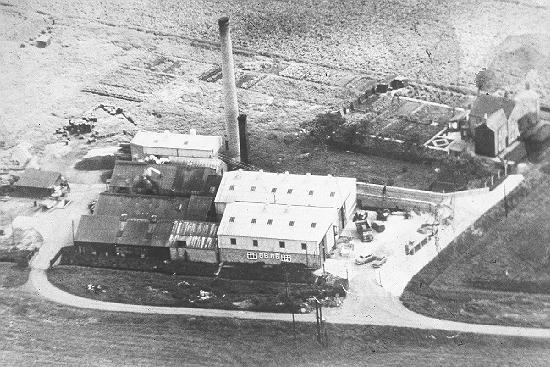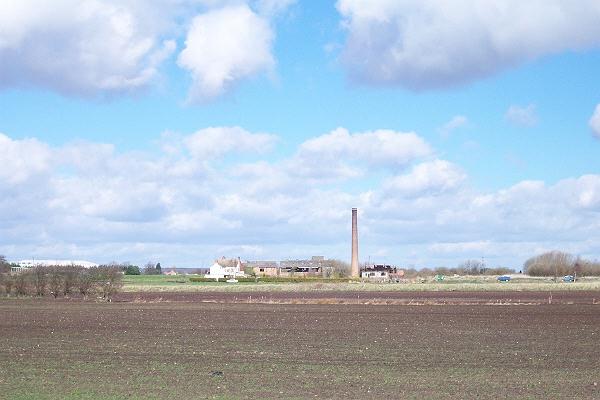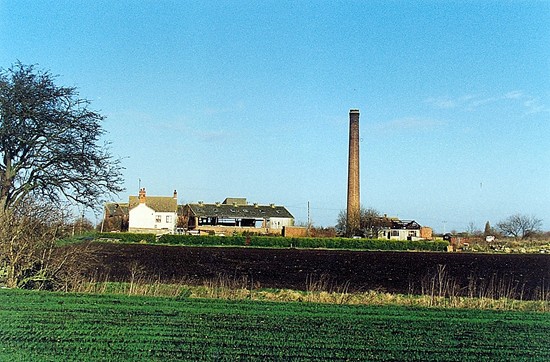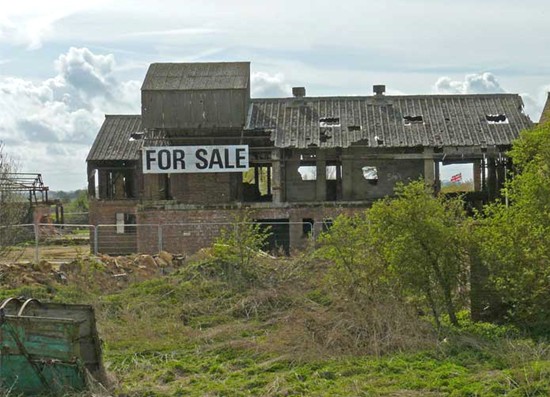|
The glue factory at the Slipe
OWNED BY T
W MAYS AND SONS LTD

An aerial shot of the glue factory taken in 1955
Industrial odours have been a constant problem in Bourne
over the years but recent complaints about a factory chimney and a vegetable
processing plant pall into insignificance when compared with the terrible pong
that once emanated regularly from the animal waste processing plant at the Slipe
in South Fen, also known as the solvent extraction factory.
The factory was owned by T W Mays and Sons Ltd, a company with diverse
agricultural interests, particularly fallen stock which was collected and
processed at a slaughterhouse and skin yard on the banks of the Bourne Eau
behind Eastgate and the meat and offal dealt with in a by-products factory while
the manufacture of fertiliser was a major boost to its business. Carcasses of
livestock such as horses, cattle and sheep were brought in by cart and it was
the firm's proud boast in a tradesmen's catalogue of 1909 that "every atom of
the carcasses reaching these works would be turned to some commercial account".
The Slipe factory was run by a subsidiary company, Mays (By-Products) Limited,
and was used to turn hooves, horns and bones into glue, a
malodorous process and one that plagued the town, particularly during hot
weather when the stink became so pungent that it wafted in from the fen whenever
an east wind was blowing and penetrated shops, houses and schools and as a
result, the premises soon became known as "the Bovril factory".
For twenty years, townspeople put up with the smell and the company spent large
sums on special equipment designed to reduce the nuisance and monitor its
effects but to no avail. In February 1975, a local factory owner, Mr Colin
Walker, protested to South Kesteven District Council that the smell was
sickening and the stench from processing waste running into a dyke near to his
premises so nauseating that his men were unable to continue with their work and
several had threatened to give notice unless there was an improvement. But by
the time his complaints was heard by the appropriate committee, the company had
given assurances that the nuisance had ended and a representative was also sent
to see Mr Walker to give assurances that it would not return. Mr A E Gooch,
manager of Mays (By-Products) Limited, said: "We have assured Mr Walker that we
will not let this happen again and we are co-operating to the fullest with the
local authorities."
But within a few months, the pong had returned and by the summer of 1978, Bourne decided that
enough was enough and so many complained to South Kesteven District Council that
firm action became unavoidable. A report on the problem was drawn up by the
Chief Environmental Health officer, Geoffrey Fox, and the environmental health
committee met in July to consider it and decide whether the firm should be
ordered to either curtail the nuisance or face an abatement notice which could
have forced them to end production.
The company fought back, saying that steps were being taken to reduce the smell
and that they were monitoring the results but their new equipment was not yet
fully operational and in the meantime, anything that was done to hamper
production at the factory could jeopardise the future of the firm and the jobs
of thirty workers employed there. But committee members were on fighting form
and Councillor Douglas Reeson was unequivocal in his condemnation of the
annoyance and even health hazard it was causing because he told the committee in
an eloquent address:
Perhaps the firm has tried to do
something about it but that does not help the people living in Bourne who have
to put up with this stink. I live a mile and a half from the factory and can
clearly detect it when the wind is in the right direction. The smell is quite
appalling. One cannot explain just how abominable it is. I would like to be able
to bring a sample of it here in a can in order that members can experience it
for themselves. We should warn this company that unless this stench is
contained, we will be taking further action against them. The people of Bourne
cannot live with it whether there are thirty jobs at stake or not. This is a
nuisance that has been dragging on for years and the horrible aroma has been
coming from this factory ever since I started attending council meetings when
they were held at the Corn Exchange. I do not think that anyone should be asked
to live with this sort of unpleasant odour. I feel very strongly about the
possibility of people being put out of work but there are thousands of others
living in this town who might reasonably expect some relief from this awful
nuisance.
There was a further complaint at the meeting that many also found the company’s
practice of transporting animal remains through the town centre in open lorries
totally objectionable and this was considered by councillors to aggravate what
had become an unacceptable annoyance. The committee voted unanimously that the
situation could not continue and agreed to give the company one last chance to
end the nuisance and it was obvious that the writing was on the wall to ensure
that the smell disappeared completely.
But the complaints persisted and although the intensity of the smell was reduced
it was never completely eradicated and eventually the problem was overtaken by
events because the firm's prosperity was not to last and the factory ceased
production on 2nd March 1980 with the closure of the T W Mays company's
operations in Bourne. The building was used in
later years as a practice location for the local fire brigade but soon became
badly neglected and dilapidated and awaiting a buyer while the tall chimney
remained a landmark on the skyline for a few more years, a reminder of its once
prominent place in the commercial life of the town until it was demolished in
2005. It was the end of an era and farewell to the terrible pong.
The buildings were left to moulder and deteriorate and in March 2010 a local
property company applied for planning permission to redevelop the site as an
industrial estate with six factory units within the existing buildings and a
further 13 in a new landscaped extension. But the project never materialised and
the following year the property was still on the market.
|
PHOTO ALBUM |
|
 |
 |
 |
|
The top picture shows the glue factory as it was in later years with views of Mays' Sluice in Cherryholt Road
and the former fertiliser factory.
The other photographs show the Slipe from across the fen and the bottom picture
of the property was taken in 2011 when it was still on the
market.
|
|
 |
REVISED FEBRUARY 2015
Return to T W Mays and Company Ltd

Go to:
Main Index Villages
Index
|




